Table of Contents
- Are Exercise Bikes Dangerous?
- Health Benefits of Exercise Bikes
- Cardiovascular and Muscle Benefits
- Mental and Functional Benefits
- Safety Concerns and Risks of Exercise Bikes
- Common Injuries and Causes
- Equipment Malfunctions
- Comparison to Outdoor Cycling
- Safety Tips for Using Exercise Bikes
- Proper Bike Setup
- Safe Usage Practices
- Maintenance and Inspection
- Who Should Avoid Exercise Bikes?
- High-Risk Groups
- Precautions for Beginners
- FAQ Section
- Final Thoughts
- About Author
- Mariar Fernandez
As an Amazon Associate, I earn from qualifying purchases.
Are Exercise Bikes Dangerous?
Are Exercise Bikes Dangerous? exercise bikes are generally safe for most users when used correctly, offering low-impact cardiovascular benefits. However, risks like joint strain, falls, or equipment malfunctions can occur without proper setup, usage, or maintenance. Following safety guidelines minimizes these dangers.
Health Benefits of Exercise Bikes
Are Exercise Bikes Dangerous? Exercise bikes provide significant health benefits, making them a popular choice for home and gym workouts. Their low-impact nature suits various fitness levels, from beginners to advanced athletes.
Cardiovascular and Muscle Benefits
Stationary biking boosts heart health, strengthens leg and core muscles, and aids weight management. A 2021 review in Clinical Rehabilitation found that regular stationary bike use reduced pain and improved function in people with knee osteoarthritis. Another study showed that individuals with rheumatoid arthritis who cycled for six months experienced reduced disease activity and stronger muscles.
- Heart Health: Cycling raises heart rate, improving cardiovascular function and reducing risks of heart disease, stroke, and high blood pressure, per a 2019 review.
- Muscle Strength: Engages quadriceps, hamstrings, and core, supporting joint stability.
- Weight Management: Burns 400-600 calories per hour at moderate intensity, depending on body weight and effort.
“Stationary biking is an ideal low-impact exercise for people with arthritis,” says Jessica Schwartz, a physical therapist and spokesperson for the American Physical Therapy Association.
Mental and Functional Benefits
Cycling enhances mental well-being and physical coordination. Regular sessions improve mood, reduce anxiety, and boost cognitive function, especially in older adults. A 2019 study linked cycling to better executive functioning and positive daily choices.
- Mental Health: Releases endorphins, reducing stress and depression symptoms.
- Balance and Coordination: Stabilizing the bike improves gait and reduces fall risk, crucial for aging populations.
For more on cycling’s health benefits, visit the Arthritis Foundation.
Safety Concerns and Risks of Exercise Bikes
While exercise bikes are safer than outdoor cycling, potential risks exist if proper precautions are ignored. Understanding these dangers ensures safer workouts.
Common Injuries and Causes
Improper use or equipment setup can lead to injuries. Data from the U.S. Consumer Product Safety Commission (CPSC) estimates 51,000 bicycle-related injuries (including stationary bikes) treated in U.S. emergency departments annually.
- Joint Strain: Overuse or incorrect bike fit can stress knees, hips, or lower back.
- Falls: Improper mounting/dismounting or loose components may cause falls.
- Muscle Soreness: Overexertion without gradual progression can lead to strains.
“Incorrect bike setup, like a saddle too high or low, can cause discomfort or injury,” notes Sheena Alva, a physical therapist at the Hospital for Special Surgery.
Equipment Malfunctions
Faulty or poorly maintained bikes pose risks. The CPSC reported rare cases of pedal or seat detachment in low-quality models, leading to falls or injuries. Regular maintenance checks prevent such issues.
| Risk Factor | Potential Injury | Prevention Tip |
|---|---|---|
| Improper Saddle Height | Knee/Back Pain | Adjust saddle to hip level when standing |
| Loose Pedals | Falls | Tighten pedals monthly |
| Overexertion | Muscle Strain | Start with low resistance, short sessions |
Comparison to Outdoor Cycling
Stationary bikes eliminate outdoor hazards like traffic or uneven terrain. A 2015 study highlighted that vehicle collisions are the primary danger for outdoor cyclists, a risk absent in stationary biking. Indoor cycling also avoids weather-related accidents, making it safer for those with balance issues.
Learn more about outdoor cycling risks from the Harvard Gazette.
Safety Tips for Using Exercise Bikes
Adhering to safety guidelines minimizes risks and enhances the workout experience. Follow these steps for safe stationary biking.
Proper Bike Setup
Correct bike setup prevents strain and injury. Consult a professional or manual for adjustments.
- Saddle Height: Set so knees are slightly bent at the pedal’s lowest point.
- Handlebar Position: Adjust to avoid hunching; align with saddle for upright bikes.
- Pedal Straps: Secure feet to prevent slipping, but avoid overtightening.
Safe Usage Practices
Gradual progression and proper form are key to avoiding injuries.
- Warm-Up: Start with 5-10 minutes of low-resistance pedaling.
- Progress Slowly: Increase resistance and duration over weeks, not days.
- Posture: Maintain a straight back and relaxed shoulders to reduce strain.
Maintenance and Inspection
Regular checks ensure equipment safety.
- Inspect Components: Check pedals, saddle, and handlebars for stability before each use.
- Clean and Lubricate: Prevent wear by cleaning sweat off the bike and lubricating moving parts.
- Professional Servicing: Schedule annual tune-ups for high-use bikes.
For detailed maintenance tips, refer to the CPSC’s Bicycle Safety Guidelines.
Who Should Avoid Exercise Bikes?
Certain individuals should consult a healthcare provider before using exercise bikes to avoid exacerbating health conditions.
High-Risk Groups
- Joint or Back Issues: Those with severe arthritis or spinal conditions may experience pain without proper bike fit.
- Cardiovascular Conditions: Individuals with heart disease should monitor intensity to avoid overexertion.
- Balance Disorders: People with severe balance issues may struggle with mounting/dismounting.
Precautions for Beginners
New users should start with short, low-intensity sessions and seek guidance from a trainer or physical therapist to ensure safe form. A 2019 Healthline article recommends consulting a doctor for those recovering from injuries or with chronic conditions.
Explore additional precautions at Healthline’s Exercise Bike Guide.
FAQ Section
Q: Can exercise bikes cause knee pain?
A: Yes, if the saddle is too high or low, or if resistance is too high for your fitness level. Proper setup and gradual progression prevent strain.
Q: Are exercise bikes safe for seniors?
A: Generally, yes, due to their low-impact nature. Seniors with balance or joint issues should consult a doctor and use recumbent bikes for added stability.
Q: How often should I maintain my exercise bike?
A: Check components before each use and schedule professional servicing annually. Clean and lubricate monthly for high-use bikes.
Q: Are exercise bikes safer than outdoor bikes?
A: Yes, they eliminate traffic and weather-related risks, making them ideal for those with balance concerns or beginners.
Final Thoughts
Exercise bikes offer a safe, low-impact way to improve cardiovascular health, strengthen muscles, and enhance mental well-being. While risks like joint strain or equipment issues exist, they are minimal with proper setup, usage, and maintenance. Compared to outdoor cycling, stationary bikes provide a controlled environment, ideal for diverse populations, including seniors and those with joint concerns. Always consult a healthcare provider if you have pre-existing conditions, and follow safety guidelines to maximize benefits and minimize risks. For further reading on safe cycling practices, visit the National Highway Traffic Safety Administration.







